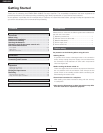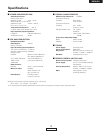
ENGLISH
• Speaker impedance
• When using speaker systems A and B separately, speakers
with an impedance of 4 to 16 Ω/ohms can be connected.
•When biwiring with biwireable speaker system, speakers
with an impedance of 4 to 16 Ω/ohms can be connected.
• Note that when using two sets of speaker systems together
(A + B), use speakers with impedance 8 to 16 Ω/ohms,
using speakers with an impedance other than between 8 to
16 Ω/ohms may cause damages.
Note that this unit is not equipped with a switch for
selecting the speaker system. The A and B speaker output
terminals are connected in parallel.
• The protective circuit may be activated if speakers with
other impedances are connected.
• Be sure to connect the cords between the speaker terminals
and speaker systems with the same polarities (< to <, > to
>). If not, the central sound will be weak and the position of
the different instruments will not be clear, diminishing the
stereo effect.
• When connecting the speakers, be sure that the core wires of
the speaker cords do not stick out from the terminals and
touch other terminals, each other or the rear panel.
• Connecting the speaker cords
q Peel off the sheathing from the end of the cord.
w Twist the core wires.
e Turn the speaker terminal counterclockwise to loosen it.
r Insert the core wires entirely, then turn the terminal
clockwise to tighten it.
Protective Circuit
This set is equipped with a high speed protective circuit.
This circuit protects the internal circuitry from damage due
to large currents flowing when the speaker jacks are not
completely connected or when an output is generated by a
short circuit. This protective circuit’s operation cuts off the
output to the speakers. In such a case, be sure to turn the
power off and check the connections to the speakers. Then
turn the power on again. After muting for several seconds,
the set will operate normally.
NOTE:
Never touch the speaker terminals when the power is on.
Doing so could result in electric shocks.
Connecting the speakers
Connections
NOTE:
• Do not plug in the power supply cord until all connections are
completed.
• Be sure to connect the left and right channels properly.
• Insert the plugs securely. Incomplete connections can result
in noise.
• Note that placing the pin plug cords next to power supply
cords or near power transformers may result in humming or
other noise.
• The PHONO input terminals have an extremely high
sensitivity, so avoid turning up the volume when no pin plug
cords are connected. Doing so may result in induction
humming (booming) from the speakers. When pin plug cords
are not connected, insert the included short-circuit pin plug.
Either tightly twist or terminate
the core wires.
Speaker cords
Speaker terminal
7
ENGLISH


















